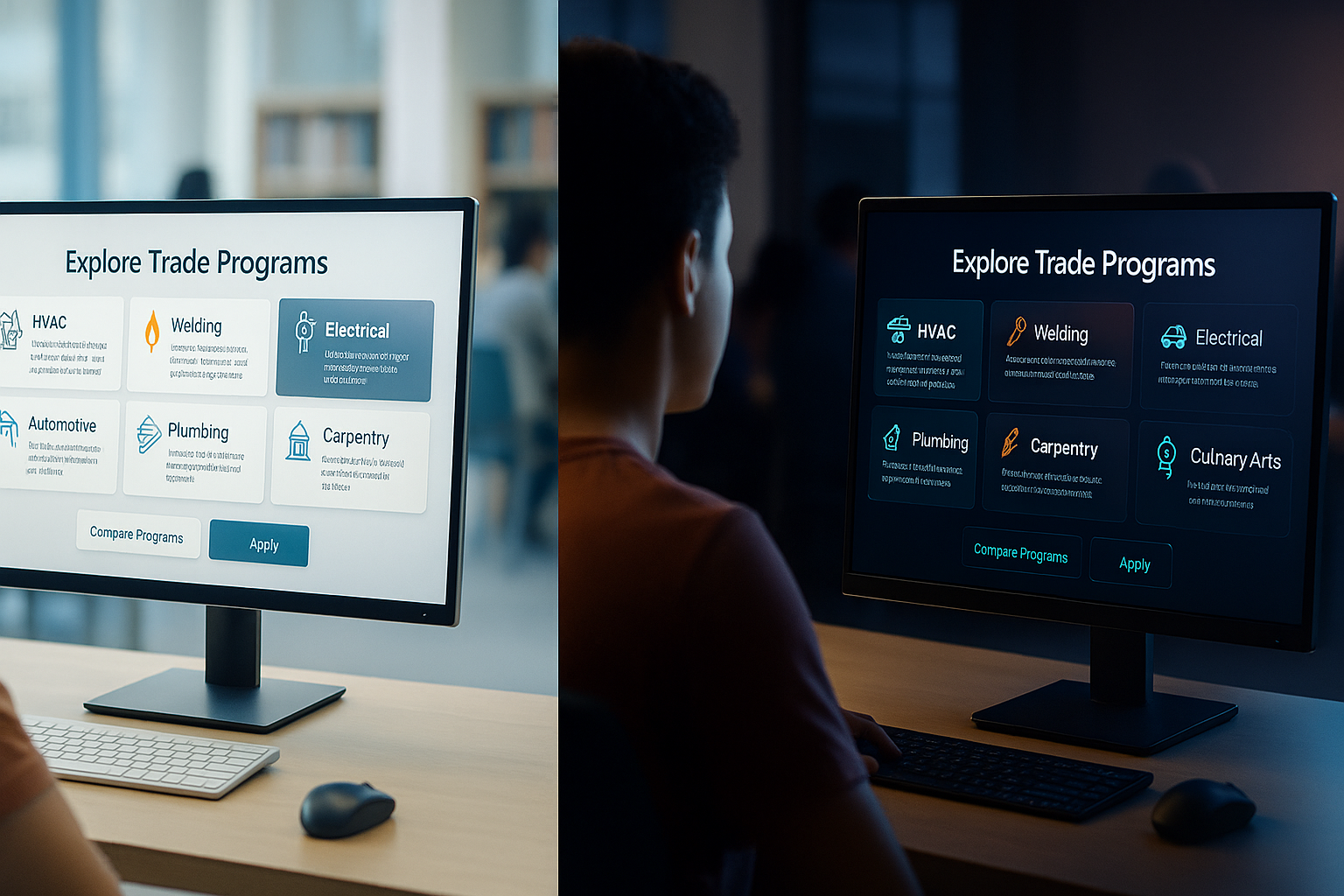Should You Choose a Trade College in 2025? A Student‑Friendly Guide
Who this is for: high‑school students, recent grads, and advisors
Big idea: Trade college (career/technical certificates, two‑year programs, and paid apprenticeships) can be a faster, cheaper, and lower‑risk path to a good job—often with strong satisfaction—especially if you like hands‑on work and want to start earning sooner.
TL;DR
- Faster to a paycheck: Many programs take months, not years, and apprenticeships are paid from day one. Source: U.S. DOL Apprenticeship.
- Lower cost (less debt): Four‑year budgets commonly run ~$30k (public in‑state) to ~$63k (private) per year. Trade programs often cost a small fraction of that. Source: College Board – Trends 2024 (PDF).
- Real demand right now: Big need in construction, energy, and healthcare support roles—clean energy is growing faster than the overall economy. Source: DOE USEER 2024.
- Solid early pay: Many trades start around $50–65k median and rise with overtime/experience. Sources: BLS OOH for Electricians, Plumbers, Wind Techs, Surgical Technologists.
- Not a free lunch: Physical work has risks; construction had 1,075 fatalities in 2023, with falls a leading cause. Source: BLS CFOI 2023, BLS TED.
Why trades make sense right now
1) The money math
- You earn sooner. Apprenticeships are jobs with training, which means a wage while you learn plus a recognized credential. Source: Apprenticeship.gov.
- You borrow less. Full annual budgets for four‑year colleges often land between ~$30k and ~$63k. Many trade programs cost low five figures total, not per year. Source: College Board – Trends 2024.
- Debt stress is real. Student‑loan delinquencies have been rising again, according to the New York Fed. Source: NY Fed – Household Debt & Credit and Q1 2025 report (PDF).
Bottom line: Getting to income sooner, with less debt to service, tilts the early financial advantage toward trade college for many students.
2) Employers are hiring
- Skilled‑trades shortages persist. Construction and specialty contractors continue to report hiring gaps. Example: ABC 2025 – 439k workers needed.
- Clean‑energy tailwinds. The U.S. energy workforce hit new highs; clean‑energy roles grew faster than the overall economy in 2023. Source: DOE USEER 2024 overview and full report (PDF).
3) The pay is competitive (especially net of debt)
- BLS medians (May 2024):
- Electricians: $62,350
- Plumbers/Pipefitters: $62,970
- Wind Turbine Technicians: $62,580
- Surgical Technologists: $62,830
- Yes, bachelor’s still pays more on average over a full career, but your major, region, and debt load matter a lot. Early on, lower debt + overtime can make trades very competitive. See: NCES COE – earnings by attainment and At‑a‑Glance.
- Short‑term ROI can favor trades. Some certificate and associate programs show the strongest 10‑year ROI; bachelor’s often overtakes later if you finish. Source: Georgetown CEW ROI 2025.
4) Fulfillment matters, too
- 9 in 10 tradespeople are satisfied with their work, citing autonomy, visible impact, and a clear path to owning a business. Source: Angi Skilled Trades Report 2024.
- Work‑based learning helps. Internships and apprenticeships are linked to better outcomes and confidence. Source: Strada – The Power of Work‑Based Learning (PDF).
Reality check: the downsides
- It’s physical and safety‑critical. Construction and some maintenance roles involve heights, heavy gear, weather, and strict safety rules. 2023 saw 1,075 construction fatalities; falls are a leading cause. Sources: BLS CFOI 2023, BLS TED, and OSHA Common Stats.
- Cyclicality is real. Construction can slow with seasons and interest rates.
- Licenses & steps. Many trades require state licensing and ongoing education. Plan your pathway (school → apprenticeship → license → master level).
When trade college is likely the better fit
- You want a paycheck soon (months, not years).
- You dislike big debt and like learning by doing.
- You enjoy hands‑on problem‑solving and visible results.
- Your region is building (infrastructure, housing, clean energy, hospitals).
Examples of fast paths:
HVAC, electrical, welding, solar installation, surgical technology—often < 24 months to employability, with apprenticeships offering paid training. See salary/outlook in BLS OOH: Electricians, Plumbers, Wind/Solar.
When a bachelor’s degree may be smarter
- You’re aiming at regulated fields (engineering, nursing BSN, accounting/CPA), research, or roles where a BA/BS is the ticket in.
- You want broad academic exploration and you’re confident you’ll finish. (Completion matters.) See: BLS “Education Pays”, NCES earnings.
15‑Minute Advisor Playbook (students can use it, too)
- Check demand & pay: Look up 2–3 occupations in your area via the BLS OOH:
Electricians,
Plumbers,
Wind Techs,
Solar Installers,
Surgical Technologists. - Compare total cost & time: Program length + living costs vs. four‑year budgets. Include opportunity cost (years not earning). Source: College Board – Trends 2024.
- Set a borrowing cap: Use the NY Fed dashboard to understand loan risks; if projected debt > your first‑year pay, rethink. Source: NY Fed.
- Prioritize work‑based learning: Programs that guarantee apprenticeships/clinicals usually have stronger outcomes. Source: Strada.
- Safety plan: Review OSHA/BLS safety data; ask schools about safety training and equipment. Sources: BLS CFOI 2023, OSHA.
- Stack your pathway: Can your certificate roll into an associate, and later a bachelor’s if your goals change? Many apprenticeships carry college credit—ask the program. Source: Apprenticeship.gov.
Quick comparison
| Dimension | Trade college / Apprenticeship | Four‑year college |
|---|---|---|
| Time to income | Months; paid training in apprenticeships | 4+ years; internships may help |
| Upfront cost | Lower; many finish with little/no debt | Higher; budgets often ~$30k–$63k/yr |
| Early wages | Many trades ~$50–65k median; overtime boosts | Wide range; bachelor’s premium shows more over time |
| Demand visibility | Strong in construction/energy/health tech | Varies; depends on major/market |
| Fulfillment | Hands‑on, visible results, path to ownership | Intellectual breadth, wider sector mobility |
| Risks | Physical demands, safety, cyclicality | Higher debt exposure; underemployment risk by major |
Key sources across the row: BLS OOH; College Board Trends 2024; DOE USEER 2024; NY Fed; OSHA/BLS CFOI; Strada.
Want help choosing?
Tell us your city and what you like doing. We’ll pull local wages, schools, and apprenticeship openings and build a simple plan.
References
- Wages & Outlook (BLS OOH): Electricians; Plumbers/Pipefitters; Wind Techs; Solar Installers; Surgical Technologists.
- Clean‑energy jobs (DOE/USEER 2024): Overview; Full report (PDF).
- Apprenticeships (U.S. DOL): Explore Apprenticeship; Apprenticeship.gov.
- Underemployment & labor market (NY Fed): The Labor Market for Recent College Graduates.
- College costs (College Board 2024–25): Trends in College Pricing & Student Aid 2024 – PDF.
- Earnings by attainment (NCES/COE): At‑a‑Glance; Earnings indicator.
- Satisfaction (Angi): Angi Skilled Trades Report 2024.
- Safety (BLS/OSHA): BLS CFOI 2023; BLS TED on falls; OSHA Common Stats.



